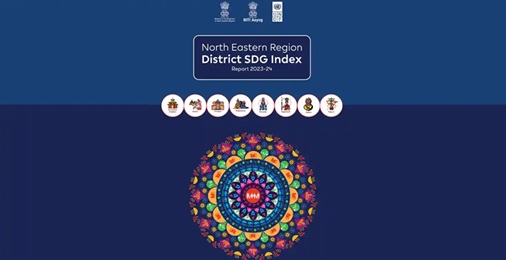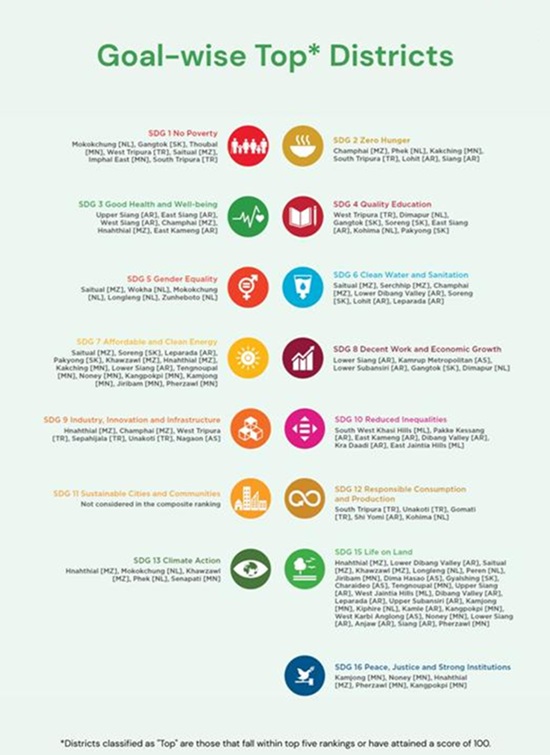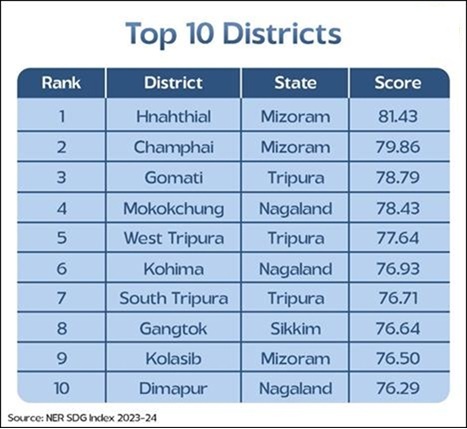(Prelims: Current Affairs)
(Mains, General Studies Paper-3: Inclusive Growth and Issues Arising from it.) |
Reference
On July 7, 2025, NITI Aayog and Ministry of Development of North Eastern Region in collaboration with United Nations Development Programme (UNDP) released the second edition of Northeast Region District Sustainable Development Goals Index.

Sustainable Development Goals
- The Sustainable Development Goals (SDGs) are a set of global goals adopted by the United Nations in 2015.
- They aim to improve lives, reduce poverty, protect nature and promote peace by the year 2030.
- There are a total of 17 goals and 169 objectives, known as the 2030 Agenda for Sustainable Development.
- In India, NITI Aayog is leading the work on SDGs.
- It links government schemes to global goals and works closely with ministries.
- The UN team in India provides support to ensure that the goals are well-aligned, inclusive and adequately funded.
About the North Eastern Region District Sustainable Development Goals Index
- The report is based on the first edition released on August 26, 2021, and shows how districts in eight northeastern states are performing in achieving 15 of the 17 Sustainable Development Goals.
- The second edition covers 121 of the 131 districts in the region. The first edition included data from 103 of the 120 districts.
- The index uses 84 indicators to measure progress.
- Of these, 41 are based on data from central government sources, while the remaining 43 come from state-level systems.
Key objectives of the Index
- To identify critical gaps and challenges in performance and achievements to plan necessary corrective measures.
- To highlight inter-state disparities across the eight States to help design appropriate solutions.
- To promote competitive federalism by enabling State-wise, District-wise and Sustainable Development Goal-wise comparisons.
- To provide a platform for collaboration and provide an opportunity for districts to share and adopt each other’s best practices.
- To identify data gaps in the statistical systems of States and Territories where better and more consistent data collection is needed.
Classification of Districts
|
SDGs Index Classification
- Successful: 100 points
- Leading: Points between 65 and 99.99
- Intermediate: Points between 50 and 64.99
- Aspiring: Points below 50
|
Overall, the proportion of districts in the leading category has increased from 62% in 2021-22 to 85% in 2023-24.

Progress on various SDGs
SDG 1: No Poverty
- The number of districts in the leading category has increased from 21 to 36. The number of aspiring districts has decreased from 20 to just 3.
SDG 2: Zero Hunger Level
- The number of leading districts has increased from 49 to 83 while the number of aspiring districts has decreased from 21 to just 1. Nutrition support schemes are making a good impact.
SDGs SDG 3: Good Health and Better Lives
- The number of leading districts has increased from 14 to 48. The number of aspiring districts has decreased from 18 to 6, reflecting better access to health services.
SDG 4: Quality Education
- The number of districts in the leading category has more than doubled from 36 to 80. The number of aspiring districts has now decreased to 11.
SDG 5: Gender Equality
- There has been substantial progress in this goal, with 112 districts now in the leading category from 71 earlier. The number of aspiring districts has decreased to just 1.
SDG 6: Clean Water and Sanitation
- The number of leading districts has increased from 81 to 114. Programmes like Jal Jeevan Mission and Swachh Bharat Mission have played a key role in this change.
SDG 7: Affordable and Clean Energy
- The number of successful districts has doubled from 7 to 14. This reflects progress in electrification of villages and use of clean cooking fuels.
SDG 8: Decent Work and Economic Growth
- The number of leading districts has increased significantly. It has increased from 69 to 111. This indicates better access to economic opportunities and employment.
SDG 9: Industry, Innovation and Infrastructure
- The number of leading districts has increased from 55 to 92 which reflects better connectivity and infrastructure planning.
SDG 10: Reducing Inequalities
- The number of leading districts is 43 this time compared to 59 in the previous index while the number of aspiring districts is 33 this time compared to 12.
SDG 12: Responsible Consumption and Production
- The number of leading districts has decreased from 67 to 51. The number of aspiring districts remained at 18 indicating the need to raise awareness about responsible consumption.
SDG 13: Climate Action
- Four districts scored 100 per cent. The number of leading districts increased from 36 to 59 but 49 districts still remained in the aspirational category indicating the need for strong climate strategies.
SDG 15: Quality of Life
- The number of successful districts increased from 12 to 26. The leading group now comprises 87 districts indicating a greater focus on forest and biodiversity conservation.
SDG 16: Peace, Justice and Strong Institutions
- There has been a steady improvement. The number of lead districts has increased from 64 to 90. However, the number of aspiring districts has also increased slightly from 1 to 5.
Top Performing Districts
- Three districts of Mizoram – Hnahthial, Champhai and Kolasib – are among the top 10 districts in the District Sustainable Development Goals Index 2023-24 for the North Eastern region.
- Three districts of Tripura – Gomati, West Tripura and South Tripura – are also included in this list.
- Mokokchung, Kohima and Dimapur of Nagaland are among the top ten districts.
- One district of Sikkim, Gangtok, is among the top ten districts.

Key Findings of the Index
- Hnahthial of Mizoram has the highest score (81.43) in the entire Northeast India while Longding of Arunachal Pradesh has the lowest score (58.71).
- Nagaland has the largest gap between its best and worst performing districts (15.07 points difference).
- Sikkim has the lowest gap (only 5.5 points), so all its districts are performing almost equally well.
- Tripura has a few top performing districts and very little gap between them (only 6.5 points).
- Mizoram and Nagaland both have high scoring districts but also have large gaps (13.72 and 15.07 points) between their best and worst performing areas.
- Programmes such as Jal Jeevan Mission and Swachh Bharat Mission have played a major role in improving access to water and sanitation.
- Local planning, regular monitoring and better data systems have helped districts perform more consistently in achieving many targets.
- Although districts have performed well in goals such as health, education, water and gender equality, challenges remain in areas such as action on climate change, inequality and responsible consumption.
- Better reporting from states has made the index more reliable.
- However, some shortcomings still persist, especially in newly created or remote districts.
